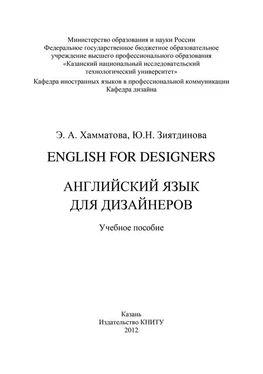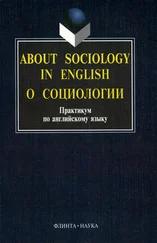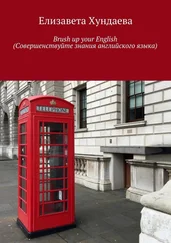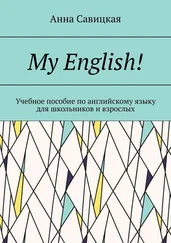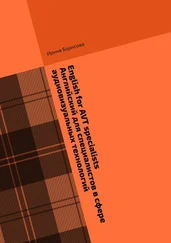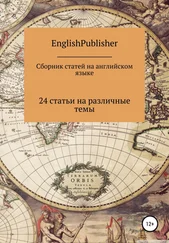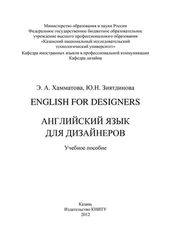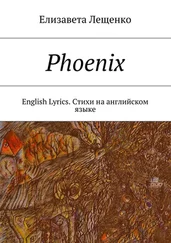Нарушается связь форм, если убрать из костюма головной убор и дамскую сумочку.
На основе анализа внешней формы костюма можно заключить, что представленная композиция является законченной и достаточно целостной, так как соблюдаются меры контраста.
9. Прочитайте и переведите цитату. Выучите высказывание наизусть.
"Fashion is not something that exists in dresses only. Fashion is in the sky, in the street, fashion has to do with ideas, the way we live, what is happening."
Coco Chanel (French fashion designer, 1883-1971)
10. Перескажите текст упражнения 4,используя фразы в приложении.
Unit 3
EIGHTEENTH CENTURY
1. Прочитайте следующие слова вслух и переведите их письменно :
robe, pleats, lavish, conical, panniers, sleeves, petticoat, bodice, redingote, silhouette, neoclassical, acumen, austerity, self-promotion, transnational, dressmaking, democracy, dissemination, bell-shaped, trumpet-shaped, hoops, empire, bust, regency, equal, inspiration, ensemble.
2. Прочитайте и переведите следующие глаголы :
to popularize, to politicize, to encase, to invert, to exaggerate, to dethrone, to unconfined, to categorize.
3. Подберите эквивалентный перевод словосочетаний из колонки A в колонке В.
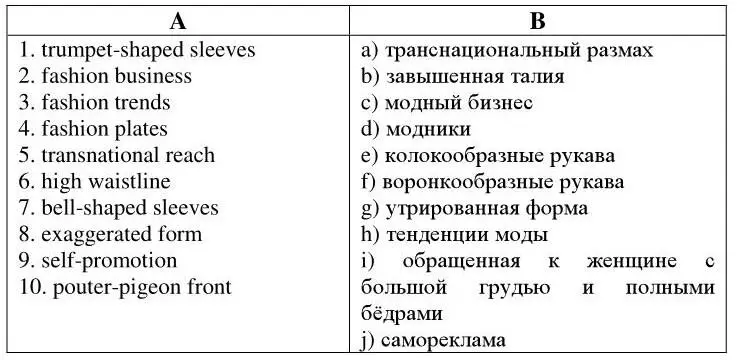
4. Прочитайте и переведите текст.
EIGHTEENTH CENTURY
The eighteenth century saw fashion celebrated as culture. One popular garment was contouche, a loose robe with large back pleats so often painted by Antoine Watteau that they came to be called Watteau pleats. Fashion icon of the day Madame de Pompadour popularized the lavish rococo style. At this point, by mid-century, the women’s torso was encased in an inverted conical corset with sleeves becoming bell- or trumpet-shaped, and the full-skirted silhouette widened further. Hoop skirts worn in the 1730s and 1740s give way to panniers, or side hoops. By 1790, although skirts remained fill, the exaggerated form had disappeared, and a fashion developed for the pouter-pigeon front, with many layers of fabric pinned to a bodice.
Riding habits and men’s tailoring found their way into women’s fashion in the second half of the century by way of the popular German traveling suit called a Brunswick gown, a two-piece ensemble that featured a hooded jacket with split sleeves and a matching petticoat; the caraco, a jacket-like bodice worn over a petticoat an based on the dress of servants and country women; and the joseph, a coat dress styled after the riding coat (adopted by the French as a redingote). After the French and American Revolutions fashion became politicized and austerity came to equal democracy. The end of the century gave regency way to an unconfined long silhouette categorized as directoire, empire or regency, with a high waistline located under the bust. Deriving its inspiration from the Greeks and Romans, this neoclassical style took Europe into the early 1800s.
One figure of special note in the eighteenth century was the dressmaker and stylist Rose Bertin. Bertin, who would later became known as the Ministre de la Mode, was instrumental in generating a passion for the latest fashions thanks to her work for the French queen Marie Antoinette, whom she dressed from 1770 until she was dethroned in 1792. Through her clever, self-promotion, business acumen, and transnational reach, Bertin helped to turn dressmaking toward a modern model of the fashion business. Contributing, too, to the wide dissemination of fashion trends by the end of the century was the rise in popularity of fashion plates and journals.
5. Ответьте на вопросы по тексту упражнения 4.
→ Who popularized rococo style?
→ What can you say about the silhouette in the end of the 18 thcentury?
→ What happened after the French and American Revolutions?
6. Прочитайте и переведите следующую цитату :
"It pains me physically to see a woman victimized, rendered pathetic, by fashion."
Yves Saint Laurent (French fashion designer, b. 1936)
7. Прочитайте, переведите текст письменно и озаглавьте его.
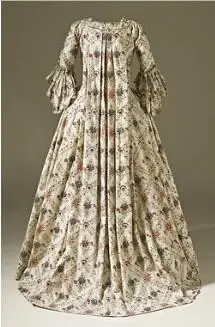
Figure.Robe à la française, France, block-printed cotton, c. 1770. Los Angeles County Museum of Art
The sack-back gown or robe à la française was a women's fashion of the 18th century. At the beginning of the century, the sack-back gown was a very informal style of dress. At its most informal, it was unfitted both front and back and called a sacque or contouche. By the 1770s the sack-back gown was second only to court dress in its formality. This style of gown had fabric at the back arranged in box pleats which fell loose from the shoulder to the floor with a slight train. In front, the gown was open, showing off a decorative stomacher and petticoat. It would have been worn with a wide square hoop or panniers under the petticoat. Scalloped ruffles often trimmed elbow-length sleeves, which were worn with separate frills called engage antes.
The loose box pleats which are a feature of this style are sometimes called Watteau pleats from their appearance in the paintings of Antoine Watteau. The various Watteau terms, such as Watteau pleat, Watteau back, Watteau gown etc., date from the mid19th century rather than reflecting authentic 18th century terminology, and normally describe 19th and 20th century revivals of the sack-back.
(From http://en.wikipedia.org)
8. Прочитайте и переведите следующие цитаты :
→ «Мода – это то, что выходит из моды». (Коко Шанель).
→ «Мода проходит, стиль остается». (Коко Шанель).
→ «Самая важная деталь в платье – женщина, которая его носит». (Ив Сен Лоран).
→ «Хорошо одетый человек тот, кто считается с собой и с другими». (Пьер Карден).
→ «Я люблю, когда мода выходит на улицу, но не допускаю, чтобы она приходила оттуда». (Коко Шанель).
9. Прочитайте текст и озаглавьте его.
This period saw the final abandonment of lace, embroidery, and other embellishment from serious men's clothing outside of formalized court dress – it would not reappear except as an affectation of Aesthetic dress in the 1880s and its successor, the "Young Edwardian" look of the 1960s. Instead, cut and tailoring became much more important as an indicator of quality.
This was also the period of the rise of hair wax for styling men's hair, as well as mutton chops as a style of facial hair.
Breeches became longer – tightly fitted leather riding breeches reached almost to the boot tops – and were replaced by pantaloons or trousers for fashionable street wear. Coats were cutaway in front with long skirts or tails behind, and had tall standing collars. The lapels featured an M-shaped notch unique to the period.
Читать дальше
Конец ознакомительного отрывка
Купить книгу
